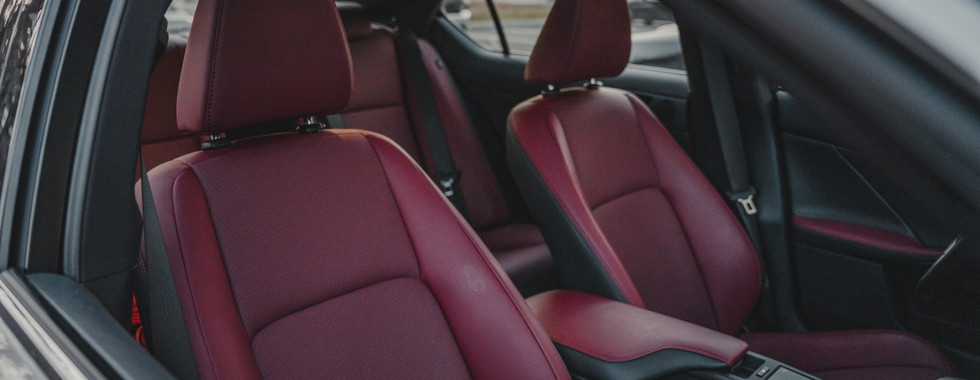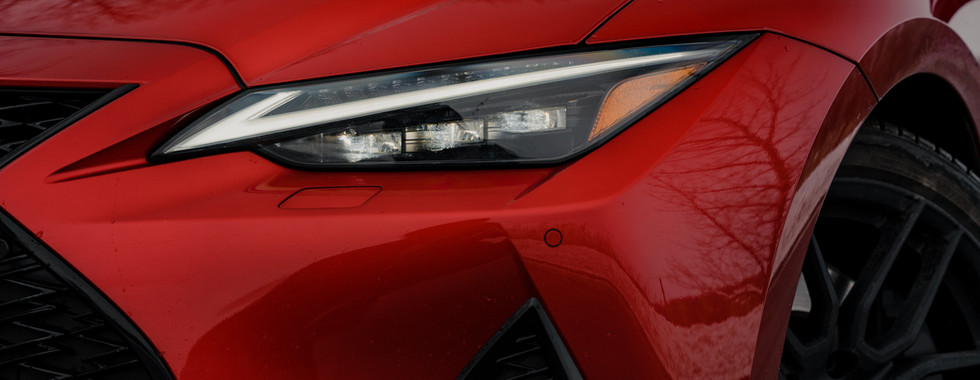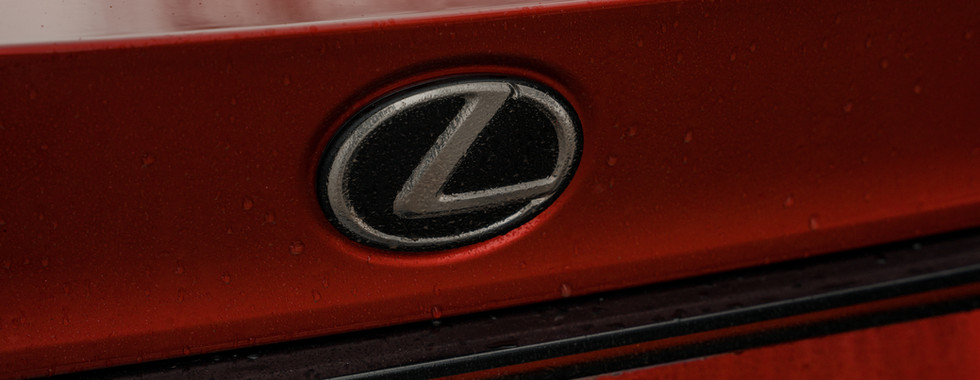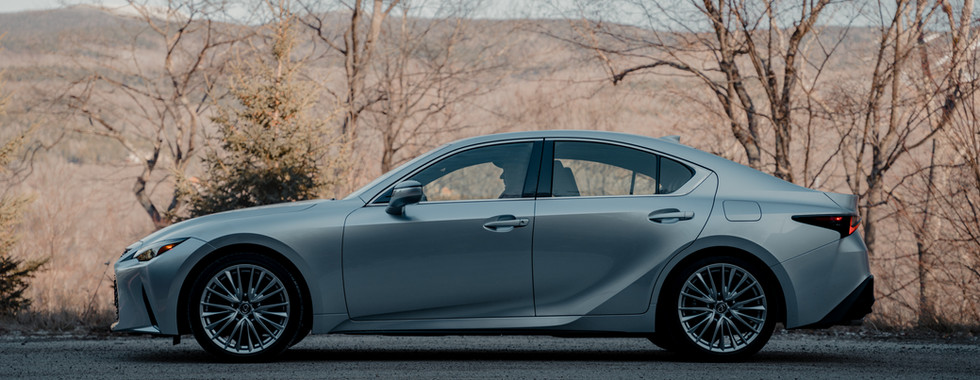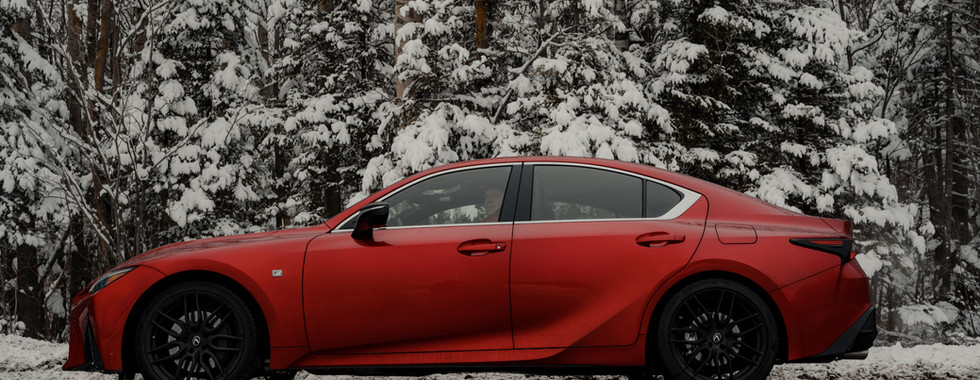Lexus IS 300 AWD vs IS 350 AWD
- Marc Gonzalez
- May 23, 2022
- 6 min read
We've had the opportunity to try Lexus's IS 300 AWD and IS 350 AWD sedans in the last few weeks. We will proceed as always, starting with our thoughts on the design and the interior, then we will move on to the aspect where they differentiate themselves, the performance aspect. All Lexus IS are imported from Japan and manufactured at the Tahara plant. The IS 300 has an MSRP of $55,390, and the IS 350 of $63,590.

Although the current generation of the Lexus IS has been on the market since the 2014 model year, Lexus gave it a much-needed refresh last year. The most noticeable changes are in the vehicle's styling; the front bumper has LED running lights shaped like an arrow placed in the lighting housing, while earlier models had them separately on the bumper. The chrome is mostly gone, giving the IS a meaner look. The taillights have a different shape on the sides, and there's now a LED bar along the trunk going from side to side. The line is subtle and clean, thus enhancing the car's look. The lower part of the bumper was painted black, and the tailpipes were less hidden. While the Lexus IS always looked good, it's now one of the best-looking sedans in its class.

Inside both cars, the Lexus IS is starting to show signs of aging. You can still find a CD player right in the middle of the console, underneath the hazard lights. You read that right, a CD reader in a luxury midsize sedan in 2022. We had the IS 300 with the red interior and the IS 350 in black. The red interior is stunning and enhances the experience, while the black interior doesn't stand out as much, and you will quickly find the flaws of this dated design. On the plus side, the steering wheel is nice and grippy. The pattern on the wheel where you're supposed to put your hands is non-skid, which is cool when you want to have more spirited driving. On the downside side, the gauge cluster is starting to feel old, especially with the minuscule TFT display in the middle on the 300 version. The cluster felt too much like a Camry and lacked the premium feeling of the rivals, especially considering the Germans are all getting full-screen gauges, and even the new 2022 Civic has one at almost half the price of the Lexus IS. In the 350 version, you get the other gauge cluster, with the huge circle in the middle and more digital information. This setup is more luxurious than the first and quirkier.
Moving on to the rest of the interior, as we mentioned earlier, right in the middle of the center console, you will find a CD player, a feature pretty much gone nowadays. Seeing this on both 2022 sedans was almost shocking. It's not as bad as the controls for the temperature, which are weird and frustrating to use since it's often difficult to select a precise temperature. Fortunately, the rest of the climate controls are much easier to use by both front occupants, and they have their part of the center console, so you will always have them on hand. The screen is large enough, which is good, but the layout in its original setting is weird, especially when you're using the touchpad. Fortunately, the screen is now touched, making this process simpler even though it's a bit far back from the driver. The Mark Levinson sound system is nearly the best in the category; it's close enough for the crown in this segment.

The rest of the interior is much more straightforward. As said earlier, the seats in the 300 were red, thus giving a different interior look compared to the regular black seats in the 350. Both of them have bucket seats, combining sport and comfort. We also like that you can get heated and ventilated seats in front. Tall drivers may feel a bit trapped, though, due to the cabin's configuration. The shape of the back seats is also more sporty. Combined with the fact that the roofline is sloping, especially in the back, it isn't ideal for adults. Still, the ISOFIX ports are easily accessible thanks to simple clips that are very appreciated. Car seat installation is simplified, making the 300 and 350 decent family sedans. The trunk is quite roomy for a midsize sedan; we were surprised to see hockey gear fit in the back. Overall, the Lexus IS stands out for its interesting use of interior space.
Up to this point, unsurprisingly, both the Lexus IS 300 AWD, and Lexus IS 350 AWD are close since it's the same car. Both vehicles are equipped with a 6-cylinder engine, ultra-reliable 3.5L, and a 6-speed automatic transmission. As mentioned earlier, both models are All-Wheel Drive, a necessity nowadays in the luxury sedan segment. They also share the same dual exhaust in the back. As for the differences now, we'll go a different way.

We were struck when we drove the Lexus IS 300 by how pleasant it feels as you turn on the engine. The rumbling of the V6 engine sounds great but not over-the-top. The traditional gear lever still present in all IS sedan is strange since almost everyone in the category has moved away from it yet feels more familiar than buttons or a knob. It's so natural and satisfying; when you want a drive more spirited, you can use the paddle shifters on the steering wheel. Speaking of it, the wheel feels great; handling is excellent on both sedans. The car is stable in high speed turns and low speeds, even in colder temperatures when we tested both vehicles. Back to the 300 specifically, the engine output has been reduced as it's one of the lowest trims in the lineup with an impressive 3 engine choices: 4, 6, or 8 cylinders. The numbers aren't that bad, and the acceleration is good, too: 260 hp and 236 lb-ft of torque from the 3.5L V6 with the 6-speed automatic transmission. When we went full throttle, we felt the car a bit slow at the speed before getting started on a highway ramp.

Now, for the Lexus IS 350, the output has been augmented to a hefty 311hp and 280 lb-ft of torque from the same engine and transmission. A move to differentiate both versions and a smart one. Does the 51hp increase make a real difference? The car feels faster from the start; the transmission does a better job of handling the power coming from the engine and directing it to the wheels. Like with the 300, this 350 handles great with the excellent steering wheel and suspension tuning in both vehicles. You sit pretty low; the advantage here is the lower center of gravity, thus improving the driving dynamics. Moreover, you can adjust the drive mode with a knob next to the gear lever, with the typical Eco, Normal, and Sport mode. With the extra Sport+ mode, when you hold the knob in that direction and the Snow mode underneath it, you'll find the best mode for the driving you're going to make. Also, when you floor it on both vehicles, the exhaust sounds incredible. As much as we love electric cars, especially at the moment with rising gas prices, we'll miss the sound of a great exhaust system.

Speaking about rising gas prices, unfortunately, there are no hybrid options in any Lexus IS. The result is a fuel consumption announced for the IS 300 of 9.0L/100km on the highway, 12.2L/100km in the city, and 10.8L/100km combined. We averaged 9.3 on the highway and 11.3 combined, figures over those announced but not by much. Lexus announced the same for the IS 350, but we were over those figures, averaging 9.5 on the highway and nearly 14.0 in the city. Those results may be due to the cold weather demanding more fuel from the engine to heat the cabin. Anyway, that is one of the biggest complaints, especially when there's a hybrid version in Europe.

All in all, the Lexus IS 300 AWD and Lexus IS 350 AWD have a similar, striking design, an outdated interior but an impressive rear trunk. As to which one you should opt for, the 350 has more power, but the 300 is more budget-friendly.

Lexus has lent us this vehicle for one week as a press vehicle. We have no affiliation with Lexus Canada. The above is a recollection of our personal opinion of the car referred above.



